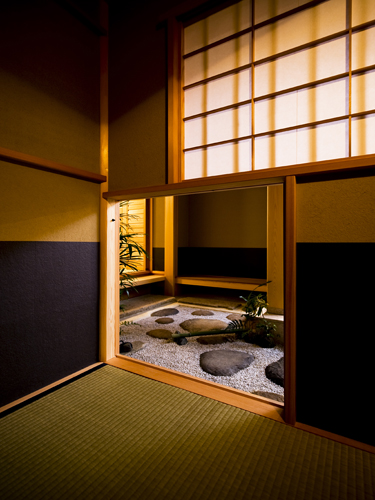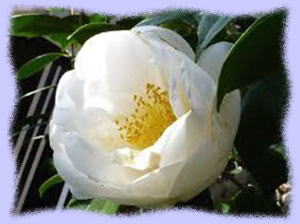Reprinted from the Omotesenke Fushin'an website
https://www.omotesenke.jp/
In the tea ceremony, a
room with four and a half tatami mats or more is called a hiroma, and a
room with four and a half tatami mats or less is called a koma. A four
and a half tatami mat room is large enough to be either a hiroma or a koma.
A koma is a tea room that does not use any shelves, including daisu, and
is used for carrying the tea ceremony. In a hiroma, tea ceremony can be
performed with various shelves, including daisu, decorated. In other words,
a koma is the world of wabi-cha, and a hiroma is the world of shoin. In
a koma, the only place for decoration is the floor, but in a hiroma, shelves
and shoin can be installed in addition to the floor. A koma has a low ceiling
and a small, low entrance, while a hiroma is no different from an ordinary
tatami room, and may have an entrance or veranda. For example, a four and
a half tatami mat room is larger than a four and a half tatami mat room,
but since the daime arrangement is in accordance with the tea ceremony
method for a koma, it cannot be called a hiroma. The term "chashitsu"
became widespread in modern times. In the past, rooms were simply called
zashiki or kozashiki, or four-and-a-half tatami mats or three tatami mats,
depending on the size. Furuta Oribe and Kobori Enshu came to call them
sukiya. Today, it seems that rooms used exclusively for tea ceremonies
are called tea rooms, and buildings that look like tea rooms with a slightly
more casual style are called sukiya. Tea rooms and roji When tea rooms
became hermitage tea rooms, the connection was lost. Instead, a space with
a doma eaves was created. Did the tea room cut off its connection with
the outdoors (nature) by surrounding it with walls? Guests walk up the
stepping stones to the stepping stones, open the nijiriguchi door, and
proceed onto the tatami mats. Here, the stepping stones and tatami mats
in the garden are directly connected. And the space for the tea ceremony
is designed to be integrated not only with the tea room, but also with
the garden outside, called the roji. The roji is not a garden to be viewed
from inside the tea room, but a path to the tea room. The tea ceremony
begins when you enter the rojiguchi. It is also important for guests to
sit on a bench while waiting for the host to greet them and to rinse their
hands in the water basin. The roji is, after all, a garden used for the
tea ceremony; it is a teahouse that opens up to the open sky, except that
it does not have a roof. The tradition of "the garden and the house
being one" lives on here as well. Rikyu called the roji "the
outer path of the floating world." It was a path that separated the
space of the tea ceremony from the secular world and sanctified it. There
is something in common with the structure of a sacred forest, with a shrine
at the very end of a long approach to a shrine.

Roji (A teahouse garden. Typically equipped with stepping stones,(Soba Kokyu)
stone basins, benches, stone lanterns, etc.)

Koma(small room)/
Nijiriguchi(Soba Kokyu)

hiroma (large room)<(Soba Kokyu)

Tea room
[The role of the tea room]
A tea room is a room set up for holding tea ceremonies in the tea ceremony,
where guests are invited and tea is served.
The typical size is four and a half tatami mats, with a tokonoma alcove,
a hearth, a nijiriguchi (a gate for guests) and a chadoguchi
(a tea ceremony entrance for the host).
A room size of four and a half tatami mats or less is called a koma(small
room), and a room size of four and a half tatami mats or more is called
a hiroma (large room).
[The origin of the tea room]
It originated from the "chaya" during the "Higashiyama culture"
in the mid-Muromachi period (1444 to 1491), and it is thought that the
space divided by folding screens and other items was the beginning of the
tea room (shoin-style tea room). After the power of the samurai class declined
due to the Onin War, it was merchants of Sakai such as Sen no Rikyu who
actively practiced the tea ceremony. The tea room they favored was the
Mountain villa in the city. Even in the midst of busy city life, people
sought a quiet and calm environment for socializing in the tea room. Tea
rooms became smaller, natural materials were used, and rooms with a rustic,
rustic atmosphere like thatched huts became popular. Rikyu further aimed
to establish his own unique world by making the tea room as small as possible.
Contemporary tea masters also preferred small tea rooms smaller than four
and a half tatami mats, and began to use various ingenuity in the limited
space. The Warring States period in which Sen no Rikyu (1522-1591) lived
was a time when lord-vassal relationships were strong, but the entrance
(nijiriguchi) was made low to show that everyone was equal in the tea room.
Samurai and merchants alike had to bow their heads to enter the nijiriguchi,
regardless of their status, and samurai could not pass through it unless
they took their precious swords, and above the nijiriguchi there was a
hanging device called a katana-gake for storing swords.




